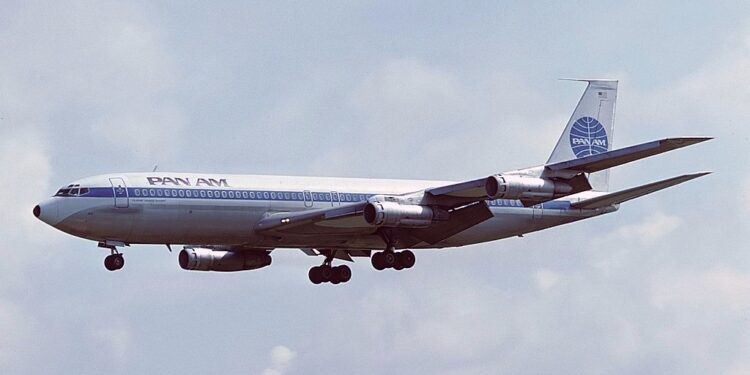On October 26, 1958, Pan American World Airways ushered in the jet age of American commercial aviation with the inaugural flight of the Boeing 707 from New York’s Idlewild Airport (now JFK) to Paris Le Bourget. This historic event marked a revolutionary transformation in air travel, setting new standards for speed, comfort, and efficiency.
The sleek Boeing 707, with its distinctive swept wings and four powerful Pratt & Whitney JT3C turbojet engines, represented a quantum leap forward in commercial aviation technology. Capable of cruising at 600 mph at altitudes above 30,000 feet, the 707 could carry up to 189 passengers across the Atlantic in just over seven hours – nearly twice as fast as the piston-engine aircraft it replaced.
Pan Am’s visionary leader, Juan Trippe, had placed a bold $269 million order for 20 Boeing 707s and 25 Douglas DC-8s in 1955. This decision, considered risky at the time, demonstrated Pan Am’s commitment to leading the aviation industry into the jet age. The British de Havilland Comet had already introduced jet travel in 1952, but technical issues had grounded the fleet, leaving the door open for Boeing’s safer, more advanced design.
The inaugural flight, piloted by veteran Captain Samuel Miller, carried 111 passengers, including journalists, dignitaries, and paying customers. The aircraft, christened “Clipper America,” symbolized the beginning of a new era in global transportation. Passengers marveled at the smooth, vibration-free flight and the unprecedented speed at which they crossed the Atlantic.
The 707’s success transformed both Boeing and commercial aviation. Orders flooded in from airlines worldwide, establishing Boeing’s dominance in commercial jet manufacturing. The aircraft’s reliability, performance, and economic efficiency made it the backbone of many major airlines’ fleets throughout the 1960s and 1970s.
Pan Am’s introduction of the 707 democratized international air travel. The jet’s greater capacity and efficiency allowed for lower ticket prices, making transcontinental and intercontinental travel accessible to a broader segment of society. This accessibility helped foster international business, tourism, and cultural exchange on an unprecedented scale.
The Boeing 707’s entry into service marked more than just a technological advancement; it represented America’s emergence as a leader in commercial aviation and symbolized the nation’s post-war economic and technological prowess. The jet age had truly begun, and air travel would never be the same again.


Recent Comments